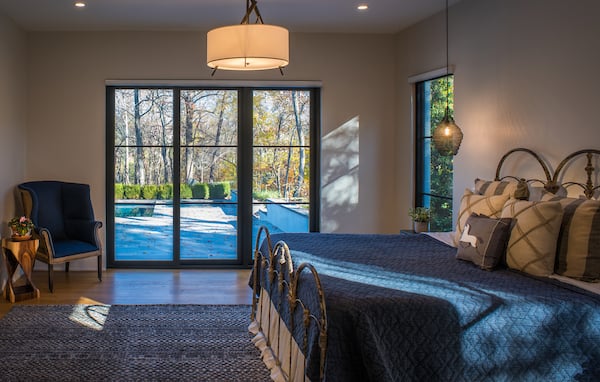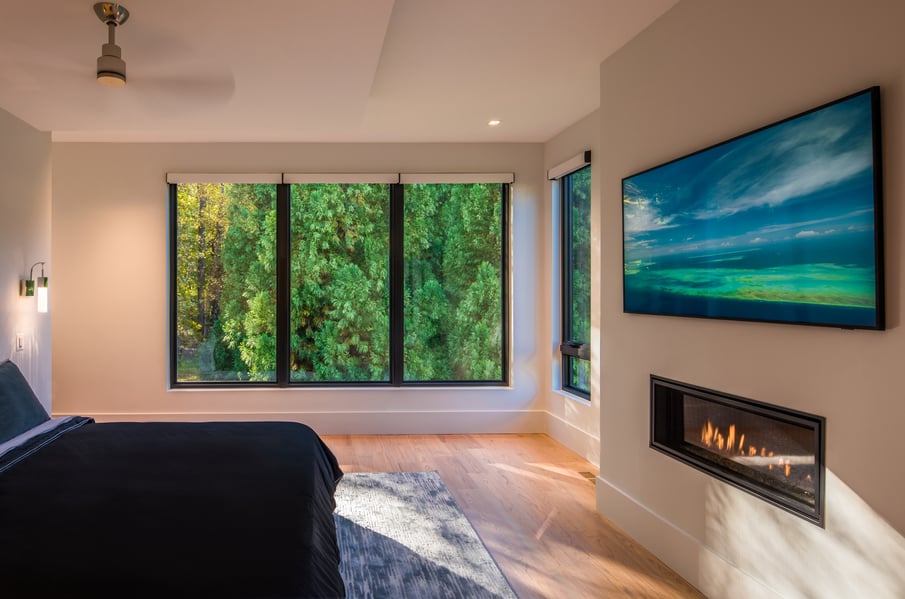How to Choose the Right Furniture for the Primary Bedroom of Your Custom Home
October 15th, 2024
4 min. read
By Sofia Alonso

Designing a primary bedroom or owner’s suite involves more than simply picking furniture after the room is built. Your furniture choices directly impact the room’s layout, flow, and functionality, so it’s important to design your space with these pieces in mind from the start. Without careful planning, furniture choices can disrupt the room’s layout, lighting, and flow. Improper placement can lead to cramped spaces or poor functionality, making the bedroom less comfortable and enjoyable over time.
At AV Architects + Builders, we’ve spent years helping clients design custom homes while seamlessly integrating furniture and layout from the start. Our expertise ensures that the primary bedroom isn’t just beautiful—it’s functional, cohesive, and tailored to how you live.
In this article, we’ll walk you through how choosing the right furniture shapes the design of your bedroom. From bed placement to lighting and seating, you’ll learn how to create a space that feels comfortable and functions perfectly. By considering your furniture needs early, you can ensure your primary bedroom is as practical as it is luxurious.
How Furniture Affects the Layout, Views, and Lighting of Your Bedroom
Furniture isn’t just about filling a space; it shapes the space. The size and placement of your bed, side tables, seating, and other pieces influence how much wall space is available, the flow of natural light, and how you’ll incorporate built-ins like closets or shelving. For instance, if you plan to have a large bed with oversized nightstands, you’ll need to account for enough wall space to fit them comfortably. The position of your bed will also affect your view of the room and where you’ll want to place windows or accent lighting.
Furniture can also dictate how you design your room’s lighting. If you’re planning to use wall sconces or hanging lights, these decisions will need to be made early so the necessary wiring can be placed in the correct spots. All these considerations should inform your design choices to ensure a cohesive, functional space.
Soft vs. Hard Furnishings: What’s the Difference?
When choosing furniture, it’s helpful to understand the difference between soft furnishings and hard furnishings:
Soft Furnishings: These are items you can take with you if you move, such as your bed, chairs, tables, and decorative pieces. Soft furnishings add warmth, style, and personality to your room. Since they’re movable, you have the flexibility to change them out as your tastes or needs evolve.
Hard Furnishings: These are permanent fixtures that are typically built into the room, such as custom cabinetry, window treatments, or built-in closets. Hard furnishings are integral to the structure and layout of the room and often require careful planning during the design phase, as they can’t be easily changed or relocated.
Planning Furniture Early in the Design Process
Furniture should never be an afterthought in your bedroom design. Planning your furniture layout from the beginning ensures that the room feels balanced and accommodates everything you need. When you design your home with furniture in mind, you can tailor the room’s size, shape, and layout to fit your pieces perfectly, making it feel spacious and functional.
Think about how you’ll use the space: Is your bedroom simply a place to sleep, or will it also serve as a place to relax, read, or watch TV? These decisions will help you figure out how much space you need for furniture, what kinds of pieces to include, and where they should be placed.
Key Questions to Ask When Planning Your Bedroom Furniture
When designing your bedroom, here are some important questions to consider when selecting and planning furniture:
1. Where will the bed go?
The bed is usually the focal point of the bedroom, so determining its placement is crucial. Consider how it will affect the room’s flow and views, and plan for windows, doors, and outlets around its location.
2. How big is the bed?
Knowing if you want a king, queen, or smaller bed is important, but so is knowing the bedframe’s size. Large headboards or footboards can take up additional space, so make sure to account for the bed’s full dimensions when planning.
3. What side tables will you use?
Consider the size and style of your nightstands. Will they match the bed’s scale, and how much storage do you need? Oversized side tables can require more wall space, while smaller ones might feel out of place next to a large bed.
4. What kind of lighting will you use?
Think about how you want to light your bedroom. Will you use table lamps, wall sconces, or hanging lights? These decisions affect where you’ll need to place outlets and wiring, so plan ahead.
 The Hill House, McLean, Virginia, AV Architects + Builders
The Hill House, McLean, Virginia, AV Architects + Builders
5. Are you going to have a bench in front of the bed?
If you want to include a bench, ensure there’s enough depth in the room for it. You’ll need space to comfortably walk around the bed and the bench.
6. Will you have seating in the room?
If you envision a cozy seating area, such as a reading nook or a place to lounge, you’ll need to plan for additional space and perhaps extra lighting or storage options to accommodate this.
.jpg?width=918&height=600&name=Photo%20(52).jpg) The Angle House, McLean, Virginia, AV Architects + Builders
The Angle House, McLean, Virginia, AV Architects + Builders
7. Will you have a TV in the room?
If you plan on having a TV, decide early where it will go. The placement of the TV affects the room layout, wiring, and how you’ll arrange your furniture.
8. Will you have window treatments?
Consider what type of window treatments you’ll need. Will they be motorized or manual? Will you want hidden or visible tracks for the curtains or blinds? These details should be decided early in the design process, as they can affect the ceiling and wall design.
 The Vista House, Great Falls, Virginia, AV Architects + Builders, Photography by Maxwell Mackenzie
The Vista House, Great Falls, Virginia, AV Architects + Builders, Photography by Maxwell Mackenzie
The Impact of Furniture Design on the Layout of Your Bedroom
Designing your bedroom with furniture in mind from the start ensures that your space is not only beautiful but also functional. By carefully considering how your furniture will affect the layout, lighting, and use of the room, you can create a bedroom that feels cohesive and tailored to your lifestyle. Whether it’s planning for the size of your bed, choosing the right lighting, or deciding on the types of window treatments, making thoughtful furniture decisions early on will lead to a more harmonious and comfortable space.
If you're ready to start designing your custom home, Schedule a Discovery Call with AV Architects + Builders to discuss your project. For more helpful tips and insights on residential design-build, visit our Learning Center for inspiration and expert advice.
Sofia Alonso is currently the Content Manager at AV Architects + Builders, a family-owned architect-led design-build firm specializing in creating modern style homes for clients in Northern Virginia. Having been with the company since 2019, Sofia has demonstrated a strong commitment to the firm's ethos of providing high-end, luxury living experiences. Sofia holds a Bachelor of Science in Interdisciplinary Studies with a focus on Writing from the University of Virginia. With Sofia contributing to the firm's content strategy, clients can look forward to insightful, educational content that perfectly aligns with the luxurious, high-quality living experiences that AV Architects + Builders is renowned for.
Topics:




